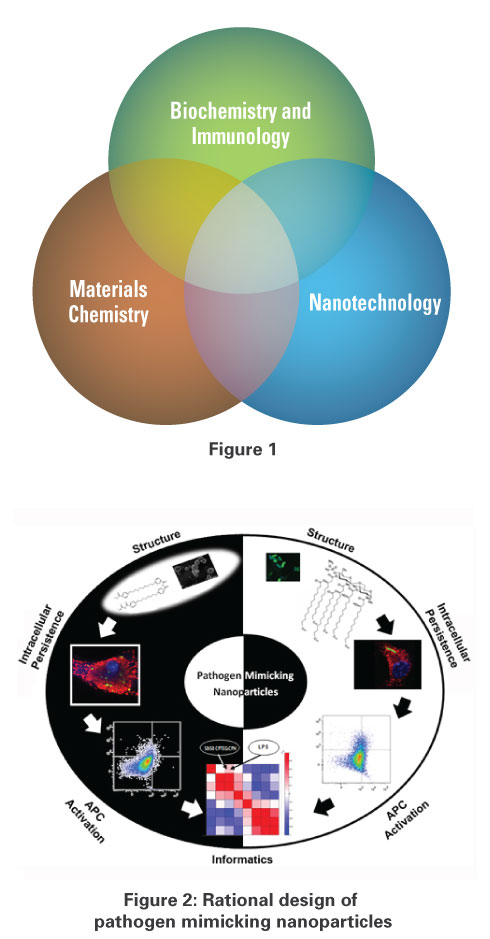 Narasimhan’s research is focused on the molecular design of nanoparticle-based platform technologies that can be broadly used to prevent and treat diseases. His work is at the intersection between materials chemistry, nanotechnology, and medicine (Figure 1). Specifically, his laboratory performs molecular design of pathogen-mimicking nanoparticles for use in sub-unit vaccine delivery platforms. Sub-unit vaccines have advantages over live or attenuated vaccines in terms of their safety and ability to not induce undesirable side effects, but typically require an adjuvant to non-specifically boost the immune response. His laboratory has developed novel biodegradable synthetic “pathogen mimicking” nanoparticles that perform dual functions as molecular adjuvants and delivery systems (Figure 2). They are based on novel amphiphilic materials synthesized in his laboratory and are decorated with pathogen-associated motifs. These non-viral adjuvants have a demonstrated safety profile and mimic pathogens in their ability to be internalized by immune cells and in their activation of immune cells, which enable the modulation of downstream immune response pathways.
Narasimhan’s research is focused on the molecular design of nanoparticle-based platform technologies that can be broadly used to prevent and treat diseases. His work is at the intersection between materials chemistry, nanotechnology, and medicine (Figure 1). Specifically, his laboratory performs molecular design of pathogen-mimicking nanoparticles for use in sub-unit vaccine delivery platforms. Sub-unit vaccines have advantages over live or attenuated vaccines in terms of their safety and ability to not induce undesirable side effects, but typically require an adjuvant to non-specifically boost the immune response. His laboratory has developed novel biodegradable synthetic “pathogen mimicking” nanoparticles that perform dual functions as molecular adjuvants and delivery systems (Figure 2). They are based on novel amphiphilic materials synthesized in his laboratory and are decorated with pathogen-associated motifs. These non-viral adjuvants have a demonstrated safety profile and mimic pathogens in their ability to be internalized by immune cells and in their activation of immune cells, which enable the modulation of downstream immune response pathways.
His laboratory has bridged fundamental studies on molecular mechanisms of immune cell activation with the development of novel nanoparticle-based platforms that can be translated into next generation vaccine products. His work has demonstrated that these particles possess the ability to rapidly traffic to the lymph nodes and prime T cells as well as to induce potent humoral responses. The nanoparticle-based platform has been developed for: vaccines against infectious diseases such as influenza, pneumonia, anthrax, and pneumonic plague; induction of cell-mediated immune responses, which are critical for diseases like cancer; and sustained delivery of antibiotics, which is being tested for the treatment of malaria and other tropical diseases. The innovative technologies developed in his laboratory have the following competitive advantages:
- Needle-free: no need for professional to administer, avoids infections
- Single dose: enhances patient compliance
- Thermal stability: breaks the “cold chain” which is a major barrier in transporting vaccines; the cold chain is estimated to contribute to almost half of the cost of a vaccine
- Combination therapies: has the potential to combine different vaccines in a single dose and also to combine antibiotic and vaccine therapies.
His research is currently funded by NSF, NIH, DOD, HRSA, and the Bill and Melinda Gates Foundation. His ongoing research activities are in the areas of nanomedicine and vaccine development for diseases such as influenza, malaria, tuberculosis, and cancer.His vision is to create a large-scale research program in nanomedicine and vaccines that will focus on the intersection between nanotechnology and molecular design of novel vaccines for new and emerging pathogens (see www.nanovaccine.iastate.edu). The research program will provide a science-driven, first principles paradigm for vaccine design leading to early commercialization in this critical health sector. This will fill the major gap that currently exists both in terms of basic research in vaccines and in pre-clinical studies that will lay the foundation for future human clinical/field trials to be successful.
A second area of focus is the design of novel amphiphilic materials for stabilization of fragile biomacromolecules such as proteins and enzymes. In this area, his research has discovered fundamental interactions between nanoparticles and micelles composed of amphiphilic materials and proteins that are critical to the rational design of protein- or enzyme-nanoparticle systems. Such systems are of paramount importance for drug delivery, biosensing, biocatalysis, biomedical imaging, and tissue engineering (Figures 3 and 4).
